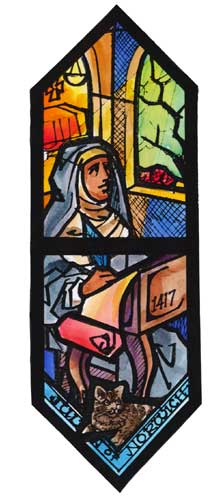|
|
|||

|
|||
Julian of Norwich
Window
 During the 14th century, Europe collapsed. Between 1347 and 1350, one-third of the population died from the Bubonic plague, with new outbreaks every decade. Cattle diseases and disastrous harvests caused famine and social unrest, and England and France fought the Hundred Yearsí War. Julian was a mystic. She saw God in places and events where, for most of us, he remains hidden. As a girl Julian desired three gifts from God: the mind of Christís passion, bodily sickness in youth, and three woundsócontrition, compassion, and willful longing toward God. In 1373, when she was thirty years old, God answered her prayer. She became ill, and after being given last rites, she experienced 16 visions of the Passion of Christ. She wrote them down in a short book called Revelations of Divine Love, becoming the first woman to write a book in the English language. After her recovery, she became an anchoress, confined to a room attached to St. Julianís Church in Norwich, England, and devoted herself to a life of prayer. For 15 years, she sought to understand her visions, until at last it was revealed that the meaning of Christís suffering was love. She then wrote a longer account of the Revelations, explaining the insights she received. This longer work is among the best spiritual literature of England. In it she wrestled with questions of free will, suffering, and sin. Though not finding definite answers, she received consolations in several forms (including beautiful metaphors of Christ as our mother), showing her that Godís love through Christ will prevail. Ultimately, enveloping all else was Godís assurance that ďI can make all things well; I will make all things well; I shall make all things well; and thou canst see for thyself that all manner of things shall be well.Ē Julianís was not mere optimism in the face of plague, famine, and war, but an unshakable faith in the cross and Passion of Christ, the supreme expression of Godís love. In our window we see Julian writing in her cell, alone, but for her cat. Her lamp represents the light of Godís revelation. We also see the two windows of her cell. One looked into the sanctuary with its altar, cross, and lamp; the other overlooked a garden where both peasants and theologians came for counsel.
Like Stars Appearing: The Story of the Stained Glass
Windows of St. George's Episcopal Church, Dayton, Ohio | |||
|
|||
